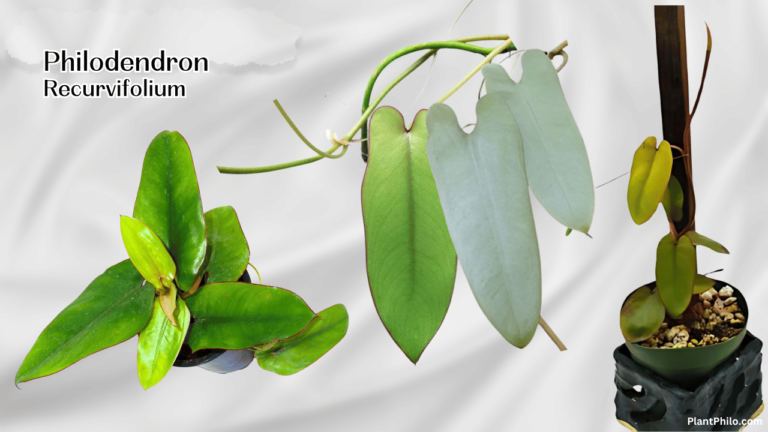Spiritus Sancti Information on Philodendron: Key Facts, Care Tips, and Identification
When I started learning about rare houseplants, I quickly found that the Philodendron Spiritus Sancti stands out from the rest. Its long, narrow leaves and striking appearance make it highly sought after by collectors.
Philodendron Spiritus Sancti is a rare aroid native to Brazil, valued for its unique foliage and scarcity.

I remember seeing photos of this plant and wanting to know what makes it so special. It prefers steady, warm temperatures and high humidity, thriving best when those needs are met in an indoor setting.
Its leaves are known for being both smooth and glossy or sometimes velvety, making each plant a little different and intriguing to own. If you’re curious about how to care for a Philodendron Spiritus Sancti or want to understand why it’s so prized, you’re in the right place.
In this post, I’ll share key facts and tips that I’ve gathered, so you can learn more about this impressive plant and what it takes to help it grow well.
Spiritus Sancti Information on Philodendron

Philodendron spiritus-sancti is a rare and highly sought-after plant with distinct characteristics. I find its unique features, endangered status, and specific growing conditions important for anyone interested in this species.
Taxonomy and Botanical Classification
Philodendron spiritus-sancti belongs to the family Araceae. It is placed within the genus Philodendron, which contains hundreds of species found mostly in tropical regions.
This plant is known for its long, strap-shaped, heart-like leaves. Mature leaves often reach 22–25 inches in length.
The petioles are long and slender, giving the plant a graceful appearance. Philodendron spiritus-sancti is a member of the Macrobelium section within its genus.
The plant can be easily identified by its smooth, glossy green leaves and its upright growth habit. Proper classification is important for conservation and cultivation.
Native Habitat and Distribution
Philodendron spiritus-sancti is native only to the Brazilian state of Espírito Santo. In the wild, it grows in warm and humid rainforests.
The environment here is steady, with year-round temperatures ranging from 66 to 76 degrees Fahrenheit and high humidity. Population numbers are alarmingly low, with very few known specimens left in nature.
Its native region faces habitat loss due to deforestation and human activity. As a result, this species is considered extremely rare and endangered.
Many cultivated spiritus-sancti plants come from seeds or cuttings grown away from their natural habitat. Indoor growers often try to mimic the rainforest conditions that this plant prefers.
More about its habitat is explained in The Spruce’s spiritus-sancti care guide.
Historical Discovery and Nomenclature
Philodendron spiritus-sancti was first officially described in scientific literature in the late 20th century. Its name comes from the state of Espírito Santo, which means “Holy Spirit” in Portuguese, marking where it was first found.
The Latin “spiritus-sancti” reflects this connection. Collectors and botanists quickly recognized its unique appearance.
Since its discovery, the desire to collect spiritus-sancti has increased, partially due to its endangered status and the difficulty of finding mature plants. Its naming and discovery play an important role in helping raise awareness for conservation efforts, as noted by Wikipedia’s entry on Philodendron spiritus-sancti.
Distinctive Characteristics of Philodendron Spiritus Sancti

Philodendron Spiritus Sancti stands out for its striking leaf shape, unique growth habits, and features that set it apart from other philodendron varieties. When I examine this plant, I notice several traits that make it a rare and highly sought-after species.
Leaf Structure and Morphology
The leaves of Philodendron Spiritus Sancti are narrow and elongated, with a distinct trifoliate shape. Each leaf forms three clear lobes, which gives it a delicate and elegant appearance compared to many other philodendrons with more rounded or heart-shaped foliage.
The leaves are dark green, smooth, and often reach impressive lengths as the plant matures. The leaf texture is leathery yet thin, making them both flexible and sturdy.
New growth may appear lighter in color before deepening to a rich green. As the plant climbs, the leaves follow a graceful drape, often resembling a ribbon in the way they hang from the stem.
Growth Pattern and Size
Philodendron Spiritus Sancti is a hemiepiphytic vine, which means it can grow both on the ground and on trees. In the wild, or under perfect conditions, I have found it can reach heights of 10 to 15 feet.
When kept indoors or as a houseplant, it typically remains smaller, depending on the environment and care. The plant starts as a small rosette but quickly begins to climb with the help of aerial roots.
These roots anchor the plant to various surfaces, allowing it to gain height and stability. Supports or moss poles are often useful for helping the plant achieve its full potential.
Unique Features Compared to Other Philodendrons
Philodendron Spiritus Sancti is easy to identify because of its completely green leaves with no variegation, unlike some other philodendron species. It is more sensitive to overwatering and requires higher humidity than many of its relatives.
It is more delicate, making proper care essential for healthy growth. The plant’s trifoliate leaves are very rare among philodendrons, creating a unique look that is not commonly seen in home collections.
For collectors and enthusiasts, these features, along with its hemiepiphytic growth, make it exceptionally prized. For more information about its distinctive traits, I refer to guides like this detailed overview of Spiritus Sancti.
Cultivation and Care Guidelines
When I care for Philodendron spiritus-sancti, I focus on their unique needs for light, temperature, soil, water, and nutrients. Making the right choices for these plants helps them grow healthy leaves and avoid common problems.
Light and Temperature Requirements
I provide my Philodendron spiritus-sancti with bright, indirect sunlight. Direct sun can damage the leaves, so I place the plant near a window with filtered light or use sheer curtains.
If natural light is low, I use a grow light to make sure the plant gets enough brightness. Temperature is important.
I keep the plant in a room where the temperature stays between 66°F and 76°F. Sudden cold drafts or hot, dry air can stress the plant.
I also watch humidity closely and keep it at average to high levels. Using a humidifier or a pebble tray under the pot can help maintain good humidity, especially in dry climates.
Soil Composition and Watering Practices
I use a loose, well-draining soil mix for my Philodendron spiritus-sancti. A mix of peat, perlite, and orchid bark works best because it keeps the roots from sitting in water.
Good drainage is critical to prevent root rot. When watering, I let the top inch of soil dry before adding more water.
I water deeply until it runs out the bottom, then empty the tray under the pot. Keeping the soil evenly moist, not soggy, is key for healthy roots.
If the leaves look yellow or the soil smells musty, I check for overwatering. More information and careful tips are provided on how to care for Philodendron spiritus-sancti.
Fertilization and Nutrient Management
During spring and summer, my Philodendron spiritus-sancti grows faster and needs extra nutrients. I use a balanced liquid fertilizer every 4-6 weeks, but I dilute it to half strength to avoid burning the roots.
In fall and winter, I reduce feeding to prevent salt buildup in the soil. If I notice slow growth or pale leaves, I check my feeding routine.
Too much fertilizer can harm the plant, while too little can cause nutrient deficiencies. For specific advice on fertilizing through the growing season, I follow the guidelines shared on how to feed Philodendron spiritus-sancti.
Conservation Status and Importance
Philodendron spiritus-sancti is a rare and highly threatened plant. I find its survival at risk because of multiple human-driven factors and limited wild populations.
Threats to Survival
This species is listed as endangered and critically endangered in specific regions due to its very limited distribution. Only three natural populations were documented by 2023, making it exceptionally vulnerable.
Habitat loss from agriculture and urban development continues to shrink its native forest home in Espírito Santo, Brazil. Illegal collection for rare plant markets further reduces its numbers in the wild.
When collectors remove plants or seeds, it lowers the chances for natural regeneration. The low number of mature plants in nature also raises the risk of extinction from fire, storms, or disease.
Conservation Initiatives
Conservation actions for this species center on preserving wild populations and discouraging illegal collection. In some areas, local and national authorities have given it protected status to limit further habitat loss.
Enforcement against poaching in known habitats helps protect remaining plants. Botanical gardens and rare plant growers also play a part.
They cultivate Philodendron spiritus-sancti from seed or tissue culture, creating backup populations outside of the wild. Education efforts teach locals and collectors about the importance of conservation.
Together, these initiatives support survival and hopefully allow the wild population to grow.
Role in Biodiversity
Philodendron spiritus-sancti provides important functions in its native ecosystem. As an aroid, it serves as a host for insects and possibly small animals, offering shelter and food in the humid forest canopy.
Its presence helps support other species in the food web. Its loss would reduce the unique plant diversity found in Southeastern Brazil.
Protecting this plant helps preserve an irreplaceable component of the Atlantic Forest, one of the world’s most threatened biodiversity hotspots. The survival of this species reflects broader conservation efforts for countless other plants and animals in its ecosystem.
Frequently Asked Questions
I have researched key information about the Philodendron Spiritus Sancti, focusing on how to care for it, its value, its unique features compared to similar plants, ways to propagate it, when it matures, and how a moss pole helps.
Each answer is designed to provide clear guidance for plant owners and collectors.
What are the care requirements for a Philodendron Spiritus Sancti?
I make sure my Philodendron Spiritus Sancti gets bright, indirect sunlight. Too much direct sun can burn the leaves.
I keep the humidity around 60% or higher by using a humidifier or placing a tray of water nearby. Watering is important, so I only water when the top of the soil feels dry.
I also use a well-draining potting mix to protect the roots. More details on care routines for this plant can be found at Greg.
How does the price of a Philodendron Spiritus Sancti compare to other rare plants?
The Philodendron Spiritus Sancti is one of the most expensive houseplants on the market. It often costs much more than other rare philodendrons due to its rarity and high demand.
Its price is higher than most aroid species found in plant stores.
What are the distinguishing characteristics between Philodendron Spiritus Sancti and Philodendron Billietiae?
I recognize the Philodendron Spiritus Sancti by its narrow, long leaves that are completely green. Unlike the Philodendron Billietiae, which can have orange petioles and wavy leaves, the Spiritus Sancti does not have any coloration or variegation.
There is a thorough guide comparing these species at Orchideeen Shop.
How can one successfully propagate a Philodendron Spiritus Sancti?
I propagate my Spiritus Sancti by taking stem cuttings that have at least one node. I place the cutting in water or moist sphagnum moss until new roots grow.
The plant prefers warm temperatures and high humidity during this process. It can take several weeks for roots to develop.
At what stage is a Philodendron Spiritus Sancti considered mature?
A Philodendron Spiritus Sancti is considered mature when it has developed its full, elongated leaf shape and larger leaf size. This may take several years, as the plant grows slowly.
Mature plants show more noticeable and dramatic foliage compared to juvenile ones.
What are the benefits of using a moss pole for a Philodendron Spiritus Sancti?
I use a moss pole to give my Spiritus Sancti extra support as it grows taller. Attaching the plant to a moss pole encourages it to develop stronger stems and larger leaves.
A moss pole also helps the plant climb, which mimics its natural growth habit in the wild. This can lead to healthier growth and a more attractive appearance.




